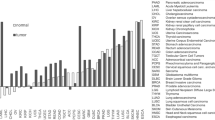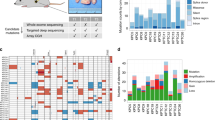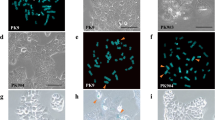Abstract
TGFα/p53+/− transgenic mice represent a genetically engineered mouse model for pancreatic adenocarcinoma. The tumors develop a characteristic pattern of secondary genetic changes. From one of these tumors, the permanent cell line TD2 was established. Here, we describe in detail the genetic changes by molecular–cytogenetic techniques. The original tumor-specific CGH profile has been retained unchanged. The most characteristic aberration pattern bears chromosome 11. Egfr, localized on proximal chromosome 11, is amplified two to three times and leads to an easily identifiable, stable marker chromosome with a large amplification unit, which is present in each metaphase. The wild-type p53 gene on distal chromosome 11 is lost. The p16Ink4a locus on chromosome 4 is hypermethylated. For c-Myc a 15-fold amplification, present in a 1.65 Mb amplification unit, is detected on chromosome 15. Transition between presence in the form of several double minutes, DMs, or a single homogeneously staining region, HSR, was observed for c-Myc. Molecular–cytogenetic analysis of both amplification units show that Egfr amplification and c-Myc amplification represent two alternative modes by which genes get amplified in tumor cells. The expression level of the respective genes was proven by Northern blot analysis. The cell line TD2 represents a valuable in vitro model for pancreatic adenocarcinoma.
This is a preview of subscription content, access via your institution
Access options
Subscribe to this journal
Receive 50 print issues and online access
$259.00 per year
only $5.18 per issue
Buy this article
- Purchase on Springer Link
- Instant access to full article PDF
Prices may be subject to local taxes which are calculated during checkout







Similar content being viewed by others
References
Bardeesy N, Morgan J, Sinha M, Signoretti S, Srivastava S, Loda M, Merlino G and DePinho RA . (2002). Mol.Cell. Biol., 22, 635–643.
Bardeesy N, Sharpless NE, DePinho RA and Merlino G . (2001). Semin. Cancer Biol., 11, 201–218.
Caldas C, Hahn SA, da Costa LT, Redston MS, Schutte M, Seymour AB, Weinstein CL, Hruban RH, Yeo CJ and Kern SE . (1994). Nat. Genet., 8, 27–32.
Curtis LJ, Yong L, Gerbault-Sereau M, Kuick R, Dutrillaux A-M, Goubin G, Fawcett J, Cram S, Dutrillaux B, Hanash S and Muleris M . (1998). Genomics, 53, 42–55.
Gilmore TD . (1999). Oncogene, 18, 6842–6844.
Greten FR, Weber CK, Greten TF, Schneider G, Wagner M, Adler G and Schmid RM . (2002). Gastroenterology, 123, 2052–2063.
Hajkova P, EI Maarri O, Engemann S, Oswald J, Olek A and Walter J . (2002). Methods Mol. Biol., 200, 143–154.
Hellman A, Zlotorynski E, Scherer SW, Cheung J, Vincent JB, Smith DI, Trakhtenbrot L and Kerem B . (2002). Cancer Cell, 1, 89–97.
Hruban RH, Goggins M, Parsons J and Kern SE . (2000). Clin. Cancer Res., 6, 2969–2972.
Kallioniemi A, Kallioniemi OP, Sudar D, Rutovitz D, Gray JW, Waldman F and Pinkel D . (1992). Science, 258, 818–821.
Ma C, Martin S, Trask B and Hamlin JL . (1993). Genes Dev., 7, 605–620.
Maurer BJ, Lai E, Hamkalo BA, Hood L and Attardi G . (1987). Nature, 327, 434–437.
Patel AC, Anna CH, Foley JF, Stockton PS, Tyson FL, Barrett JC and Devereux TR . (2000). Carcinogenesis, 21, 1691–1700.
Paulson TG, Almasan A, Brody LL and Wahl GM . (1998). Mol. Cell. Biol., 18, 3089–3100.
Sandgren EP, Luetteke NC, Palmiter RD, Brinster RL and Lee DC . (1990). Cell, 61, 1121–1135.
Sandgren EP, Quaife CJ, Paulovich AG, Palmiter RD and Brinster RL . (1991). Proc. Natl. Acad. Sci. USA, 88, 93–97.
Schwab M . (1999). Semin. Cancer Biol., 9, 319–325.
Steinle AU, Weidenbach H, Wagner M, Adler G and Schmid RM . (1999). Gastroenterology, 116, 420–430.
Toledo F, Le Roscouet D, Buttin G and Debatisse M . (1992). EMBO J., 11, 2665–2673.
Wagner M, Greten FR, Weber CK, Koschnick S, Mattfeldt T, Deppert W, Kern H, Adler G and Schmid RM . (2001). Genes Dev., 15, 286–293.
Wahl GM . (1989). Cancer Res., 49, 1333–1340.
Wang W, Abbruzzese JL, Evans DB, Larry L, Cleary KR and Chiao PJ . (1999). Clin. Cancer Res., 5, 119–127.
Weaver ZA, McCormack SJ, Liyanage M, du MS, Coleman A, Schrock E, Dickson RB and Ried T . (1999). Genes Chromosom. Cancer, 25, 251–260.
Wu Y, Renard CA, Apiou F, Huerre M, Tiollais P, Dutrillaux B and Buendia MA . (2002). Oncogene, 21, 1518–1526.
Acknowledgements
We thank Antje Kollak, Alexandra Kilian and Beate Knobl for excellent technical assistance. This work was supported by grants from the Deutsche Forschungsgemeinschaft SFB 518 (Teilprojekt B6) and IZKF Ulm (Teilprojekt C4) to RMS.
Author information
Authors and Affiliations
Corresponding author
Rights and permissions
About this article
Cite this article
Schreiner, B., Greten, F., Baur, D. et al. Murine pancreatic tumor cell line TD2 bears the characteristic pattern of genetic changes with two independently amplified gene loci. Oncogene 22, 6802–6809 (2003). https://doi.org/10.1038/sj.onc.1206836
Received:
Revised:
Accepted:
Published:
Issue Date:
DOI: https://doi.org/10.1038/sj.onc.1206836
Keywords
This article is cited by
-
Molecular biology of pancreatic cancer
Clinical and Translational Oncology (2008)
-
Non-incidental coamplification of Myc and ERBB2, and Myc and EGFR, in gastric adenocarcinomas
Modern Pathology (2007)
-
Transforming growth factor alpha acts as a gliatrophin for mouse and human astrocytes
Oncogene (2006)
-
Overexpression of c-myc in pancreatic cancer caused by ectopic activation of NFATc1 and the Ca2+/calcineurin signaling pathway
The EMBO Journal (2006)
-
Lack of EGF receptor contributes to drug sensitivity of human germline cells
British Journal of Cancer (2005)



